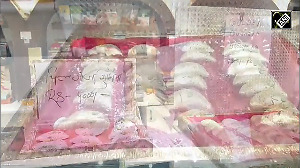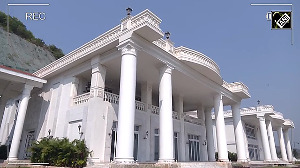I have been doing a lot of traveling around South India recently, and quite a bit of it by train; I have tasted the varied pleasures of unreserved Second Class as well as those of Chair Car, First Class AC, 2 tier AC, and 3 tier AC Sleeper. I have to agree with the likes of Paul Theroux and other travel writers that it is quite an experience.
I have always had a particular fondness for the Southern Railway Timetable. On my many trips between Madras and Trivandrum while I was a student I used to get hold of the old, badly-printed-on-rough-greenish-newsprint timetable. I was keen to figure out which train we passed and how late it was, although my companions probably thought me a trifle odd. These days, the Southern Railway Timetable is glossy, well-produced, and informative; although the railway itself has shrunk with the creation of the new South Western Railway in Bangalore.
There is an unspoken hierarchy among trains: I knew where we stood on the totem pole vis-à-vis other trains based on which one was stranded at some tiny one-horse village station waiting for the other to sweep by imperiously. The most grievous insult was when we waited for half an hour in some godforsaken backwater for a freight train to rumble by. It made one feel worthless, like pond scum.
In the old days the Madras-Trivandrum route was the meter gauge line that went directly over the Western Ghats from Quilon to Shencottah to Tenkasi. A truly spectacular ride with large, curving bridges over ravines, many tunnels, and some fair altitude. I think we used to have one locomotive pushing and the other pulling. The scenery was outstanding.
There were some thick evergreen shola forests too. I am sure these, full of old growth teak and other native flora, have been replaced by the ubiquitous rubber and other monoculture plantations now. I haven't traveled by this route for many years; it is currently undergoing gauge conversion to broadgauge and is not open for traffic.
During monsoon times, we could see what 'rainshadow' meant: on the Kerala side, the clouds were literally stopped by the Ghats, dropping their moisture content on the hillsides. Sometimes, if we were lucky, we would even go through particularly low hanging clouds: a sort of fog would envelop us.
The contrast between the rainy Kerala side and the parched Tamil Nadu side could not be more dramatic. There is a particularly long tunnel; this literally marks the border between the states and the backbone of the Ghats, I guess. When you emerge on either side, you have no doubt that you have crossed the state line: the vegetation is so different. Dense dark greenery on one side; scrubland on the other. Geography is destiny, perhaps.
Recently I took an overnight Chennai-Trivandrum train that goes primarily through Tamil Nadu; in the morning, we reached the vicinity of Tirunelveli. Once again, spectacular stretches of semi-arid land, red earth, just waiting for water. Not much grows, as rainfall is erratic; clumps of tall and slender palm trees (arecanut, I think) are seen here and there.
This land needs rain. I was reminded of the spectacular love poem by the eponymous Sangam poet ('he who sings of red earth and pouring rain'), translated by A K Ramanujan https://www.penkatali.org/kt040.html:
But in love our hearts are as red
earth and pouring rain:
mingled
beyond parting.
This is what I think of Kerala's earth: how my heart is mingled beyond parting with the red earth and pouring rain of the monsoons of my childhood. Home. San Francisco, my other home, pales in comparison, despite the Golden Gate and Twin Peaks and the Presidio.
That is my home of love: if I have ranged,
Like him that travels I return again,
Just to the time, not with the time exchanged
This is, I am sure, how the Tamil thinks of his land and of his language. Something precious, something worth living and dying for.
We continue southwards and westwards, and suddenly, there are large and strange structures: windmill farms. In this arid land, the only constant is a stiff wind. These giant, pale, aluminum trees stand out with their lazily revolving arms.
Once we head closer to Nagercoil, the scenery begins to change. We come across the last, jagged redoubts of the Western Ghats, jutting like angry teeth into the sky. The Eastern Ghats subside quietly, but the Western Ghats terminate with what looks like strenuous objections:
There is a particular peak that I have always noticed: I call it Old Man Mountain; it looks like the profile of an ancient man, lying down, and uttering a cry of despair. The nose, mouth and even the tongue are well defined from afar. It reminds me of the square jawed granite face I have seen somewhere in the American Northeast, maybe in New Hampshire.
Nagercoil is on the right side of the rain shadow, so it does have a lot more rain. It is beautiful. There are lotus filled pools and forests of banana shrubs. And paddy fields stretching to the horizon where the forbidding cliffs stand guard over them. Suddenly, the thorn shrub that abounds all over Tamil Nadu, disappears: it does not thrive where there is plenty of water.
A lot of filmmakers seem to have discovered the natural beauty of this area: it is Kerala, but not quite. In Kerala proper, it is now difficult to find large stretches of paddy fields because the high cost of labor have made them unviable. Many farmers have let their fields lie fallow, then filled them and turned them into coconut plantations or residential land. Nagercoil is what Kerala used to look like fifty years ago: after all, it was once Travancore's granary before the district was ceded to Tamil Nadu.
Adoor Gopalakrishnan's recent film Nizhalkuthu (Shadow Kill) was set in this area, and took full advantage of the stunning scenery. It boasts an outstanding performance by Oduvil Unnikrishnan as the hangman in old Travancore, who is tortured by the idea that he may have hanged an innocent young man.
At Nagercoil Junction, the train changes direction, and the engine is shuttled to the other end. We start the last leg of the journey, towards Trivandrum. The land gets increasingly moist, although this year there is a drought. The Southwest Monsoon in 2003 was scanty in Kerala and Karnataka, ironically where it usually rains just about most heavily.
On another trip from Trivandrum to Bangalore on the very slow Island Express, I noticed how Kerala's biggest river, the Nila (renamed, distressingly, as the Bharatapuzha, not a particularly euphonious name) had now become a mere trickle. There is a broad flood plain, but the actual course of the river is very narrow; due to the destruction of rainforests and sand mining, this river, much like many others in Kerala, is dying.
My most interesting journey, however, was one from Chennai to Tirupati, to seek darshan of the Lord of the Seven Hills. It was the first time in many years that I had traveled unreserved in an ordinary compartment. I was astonished at the number of vendors who came by; I was even more astonished when my companions purchased a rather unhygienic looking mango from a rather unhygienic looking vendor and proceeded to eat it with relish. When offered a bite, I declined with thanks.
There were also the usual singers and other regulars. An old man sang in an especially uninterested and appallingly tuneless fashion (reminding me of a singer in Malayalam these days that one cannot escape from. Much like the Christopher Cross phenomenon, this fellow, I hope, will be a one-hit wonder! Tamil film songs these days are far better. They rock, and I like the energetic dance videos that go with them.)
But the most spectacular fellow passengers were a band of gypsies who boarded the train, carrying a couple of rather lethal looking flintlocks. They were ragged but merry, and the women had children slung on their hips. They obviously had no tickets. I noticed that the Ticket Examiner berated them (presumably for ticket-less travel and for carrying guns) standing a careful distance away from them! They had a bloodstained bundle with them, too, I suppose whatever they had shot. The rifles were not for decorative purposes, clearly.
It is not true that it is only in unreserved that you run into interesting people. On one occasion, in a First AC coach, I met a barefoot, bearded pilgrim wearing the black and saffron clothes of a Sabarimala pilgrim, but speaking with an upper-class British accent. It tuned out that he was a Briton of Sri Lankan Tamil origin, an investment manager.
He confided that given the way he expected currencies to go, he has hedged his bets by taking out a retirement policy in Indian rupees. Clearly, he expects the rupee to appreciate considerably against the British pound and other currencies. May his tribe increase!
Comments welcome at rajeevs@rediff.co.in






 © 2025
© 2025